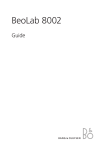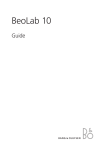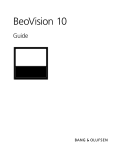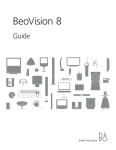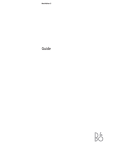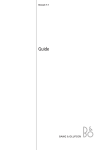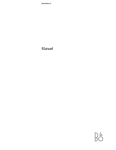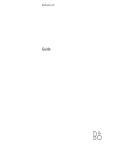Download Bang & Olufsen BEOLAB 6002 User guide
Transcript
BeoLab 6002 Guide WARNING: To reduce the risk of fire or electric shock, do not expose this appliance to rain or moisture. Do not expose this equipment to dripping or splashing and ensure that no objects filled with liquids, such as vases, are placed on the equipment. To completely disconnect this equipment from the AC Mains, disconnect the mains plug from the wall socket. The disconnect device shall remain readily operable. The lightning flash with arrowhead symbol within an equilateral triangle, is intended to alert the user to the presence of uninsulated “dangerous voltage” within the product’s enclosure that may be of sufficient magnitude to constitute a risk of electric shock to persons. The exclamation point within an equilateral triangle is intended to alert the user to the presence of important operating and maintenance (servicing) instructions in the literature accompanying the product. Daily use When you have finished setting up the loudspeakers as described on the following pages, connect the entire system to the mains supply. The indicator lights up in red, indicating that the loud speakers are in standby, ready to be used. The loudspeakers are designed to be left in this standby mode when not in use. Switching on and off – indicator When you switch on your Bang & Olufsen system, the loudspeakers switch on simultaneously. The red standby indicator light turns green, indicating that the loudspeakers are switched on. 3 If the loudspeakers are connected to a non-Bang & Olufsen system, they switch on when they receive a signal from the system (refer to p. 6). They switch off a few minutes after the signal has disappeared. Loudspeaker protection The loudspeakers are equipped with a thermal protection system which prevents overheating. If an error occurs – or the speaker units become overheated – the system automatically switches the loudspeakers to standby, and the indicator light turns orange. To restore the situation: >Disconnect the loudspeakers from the mains. >Allow the system time to reset When you switch off your system, (approximately 3–5 minutes). or mute the sound, the red indicator light appears immediately, >Reconnect the loudspeakers to the mains. indicating that the loudspeakers are not in use. Should the problem persist, contact your Bang & Olufsen retailer. Indicator Cleaning the loudspeaker Wipe dust off the surfaces using a dry, soft cloth. If necessary, remove stains or dirt with a soft, damp cloth and a solution of water and mild detergent such as washing-up liquid. Never use alcohol or other solvents to clean any part of the loud speakers! NOTE! Prolonged listening at high volume levels may cause hearing damages. Set up the loudspeaker 4 We recommend that you follow this procedure: – Disconnect your system from the mains supply. – Place the loudspeakers in your setup. – Set the switches to the correct setting. This is explained in ‘Adapt the loudspeakers to your setup’ (pages 6–7). – Connect your speaker system. – Connect the entire system to the mains again. If you mount the loudspeaker on a wall bracket, you cannot assemble the base to the loudspeaker. Cautions – Make sure that the loudspeakers are placed and connected in accordance with the instructions in this Guide. To prevent injury, use Bang & Olufsen approved stands and wall brackets only! – The loudspeakers can only be switched off completely by disconnecting them from the wall socket. – The loudspeakers are designed for indoor use in dry, domestic environments only, and for use within a temperature range of 10–40º C (50–105º F). – Remember that all speakers in a setup must be connected to a mains outlet, and that they are designed to be connected to the mains at all times, as this allows them to switch on automatically. – Do not attempt to open the loud speaker. Leave such operations to qualified service personnel! Column and base It is easiest to assemble the base and the speaker column if the loud speaker is lying on a table. In order to protect the table and the column from being scratched, we recommend that you place the wrapping foam on the table first. Hook the base plate onto the two guiding pins at the bottom of the speaker column (be careful not to drop the base plate!). Insert the three screws and tighten them securely. Cable connections The loudspeakers can be used with Bang & Olufsen audio, video and link systems. They may also be used with non-Bang & Olufsen systems. For specific information about the sockets on your system, refer to the Guide enclosed with the system. The socket panel is located at the bottom of the loudspeakers. Power Link connections: These connections carry both the right and left sound signals. Therefore, you can: 1 run a Power Link cable from your Bang & Olufsen system directly to each loudspeaker, or… 2 run a Power Link cable from your Bang & Olufsen system to the first loudspeaker, and then run another Power Link cable to the next loudspeaker. This will often help to minimise cable clutter. 5 1 POWER LINK SETUP 2 POWER LINK socket POSITION POSITION switch SETUP switch LEFT RIGHT LINE CORNER WALL FREE Connection to the mains supply POWER LINK LEFT RIGHT For safety reasons you must run the cables to and from the loud speaker through the cable guides. 1 LEFT 2 POWER LINK RIGHT Mains cord: The supplied mains cord and plug are specially designed for the product. If you change the plug or damage the mains cord, you must buy another from your Bang & Olufsen retailer! Adapt the loudspeakers to your setup 6 The loudspeakers may be placed almost anywhere in your room. However, the most natural sound is obtained if they are set up as explained on these pages. SETUP switch This switch has three settings: LEFT, RIGHT and LINE. Set the switch to LEFT or RIGHT when connecting the loudspeakers in a Bang & Olufsen system. Set the switch to LINE when connecting the loudspeakers in a non–Bang & Olufsen system. …To a Bang & Olufsen system: Use Bang & Olufsen Power Link cables to connect the loudspeakers to your system. Set the SETUP switch to LEFT and RIGHT (the left and right sound channel) respectively. The POSITION switch When a loudspeaker is placed in a corner or close to a wall, the bass level is boosted compared to the bass level from a loudspeaker placed in a more free-standing position. To remove this excessive bass boost, set the POSITION switch to ensure that the bass level suits the placement of the loudspeaker. The appropriate switch setting depends on the distance from the loud speaker to the walls and corners of the room. Use the guidelines mentioned here, when deciding which of the three POSITION switch settings to select – on each loudspeaker. …To a non-Bang & Olufsen system: The position zones, shown on the Use a special adaptor with an next page, are meant as guidelines ordinary phono/RCA plug in one – you may, of course, set the switch end, and a DIN-plug in the other. to any of the three settings you Depending on your setup, you may prefer. also need to connect an adaptor with phono/RCA and mini jack plugs (optional accessories, available from your Bang & Olufsen retailer). Set the SETUP switch to LINE. 7 Position zones: The three settings (CORNER–WALL–FREE) correspond to the position zones marked in different shades of grey. CORNER WALL FREE CORNER Use this setting if the loudspeaker is placed in a corner – shown by the dark grey areas in the illustration. WALL Use this setting if the loudspeaker is placed less than 15 cm (6") from the wall, and no closer to a corner than 50 cm (20") – shown by the grey areas along the walls in the illustration. If the loudspeaker is mounted on a wall bracket, use this setting. FREE Use this setting if the loudspeaker is placed more than 15 cm (6") from the wall, and no closer to a corner than 50 cm (20") – shown by the large light grey area in the illustration. How to measure? The distances referred to are measured as shown here (the loudspeaker seen from above). 8 Waste Electrical and Electronic Equipment (WEEE) – Environmental protection Electrical and electronic equipment, and waste prevents the potential parts and batteries marked with contamination of nature with the this symbol must not be disposed hazardous substances which may of with normal household wastage; be present in electrical and elec all electrical and electronic equip tronic products and equipment. ment, parts and batteries must be Your Bang & Olufsen retailer will collected and disposed of separately. advise you of the correct way of When disposing of electrical and disposal in your country. electronic equipment and batteries If a product is too small to be by use of the collection systems marked with the symbol, it will available in your country, you appear in the User Guide, on the protect the environment, human Guarantee certificate, or on the health and contribute to the packaging. prudent and rational use of natural resources. Collecting electrical and electronic equipment, batteries This product is in conformity with the provisions of the Directives 2004/108/EC and 2006/95/EC. 9 Technical specifications, features and the use thereof are subject to change without notice! All Bang & Olufsen products comply with applicable environmental legislation throughout the world. For the Canadian market only! This class B digital apparatus meets all requirements of the Canadian Interference-Causing Equipment Regulations. For the US-market only! NOTE: This equipment has been tested and found to comply with the limits for a class B digital device, pursuant to part 15 of the FCC Rules. These limits are designed to provide reasonable protection against harmful interference in a residential installation. This equipment generates, uses and can radiate radio frequency energy and, if not installed and used in accordance with the instructions, may cause harmful interference to radio communications. However, there is no guarantee that inter ference will not occur in a particular installation. If this equipment does cause harmful interference to radio or television reception, which can be determined by turning the equip ment off and on, the user is encouraged to try to correct the interference by one or more of the following measures: – Reorient or relocate the receiving antenna. – Increase the separation between the equipment and receiver. – Connect the equipment into an outlet on a circuit different from that to which the receiver is connected. – Consult the retailer or an experienced radio/TV technician for help. 3510483 Version 1.0 1211












